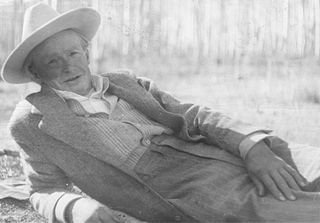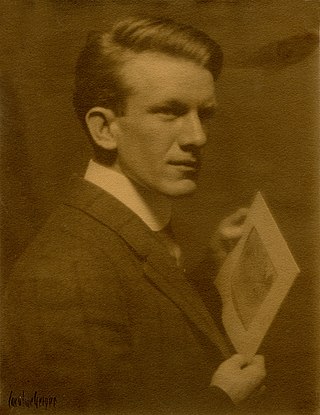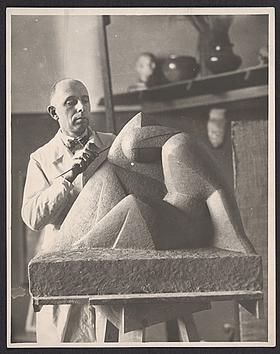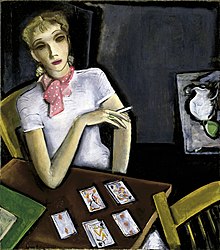
The Taos art colony was an art colony founded in Taos, New Mexico, by artists attracted by the culture of the Taos Pueblo and northern New Mexico. The history of Hispanic craftsmanship in furniture, tin work, and other mediums also played a role in creating a multicultural tradition of art in the area.

Visual art of the United States or American art is visual art made in the United States or by U.S. artists. Before colonization, there were many flourishing traditions of Native American art, and where the Spanish colonized Spanish Colonial architecture and the accompanying styles in other media were quickly in place. Early colonial art on the East Coast initially relied on artists from Europe, with John White the earliest example. In the late 18th and early 19th centuries, artists primarily painted portraits, and some landscapes in a style based mainly on English painting. Furniture-makers imitating English styles and similar craftsmen were also established in the major cities, but in the English colonies, locally made pottery remained resolutely utilitarian until the 19th century, with fancy products imported.
Henriette Wyeth Hurd was an American artist noted for her portraits and still life paintings. The eldest daughter of illustrator N.C. Wyeth, she studied painting with her father and brother Andrew Wyeth at their home and studio in Chadds Ford, Pennsylvania.

Marsden Hartley was an American Modernist painter, poet, and essayist. Hartley developed his painting abilities by observing Cubist artists in Paris and Berlin.

Arthur Bowen Davies was an avant-garde American artist and influential advocate of modern art in the United States c. 1910–1928.

John Marin was an early American modernist artist. He is known for his abstract landscapes and watercolors.

Charles Ephraim Burchfield was an American painter and visionary artist, known for his passionate watercolors of nature scenes and townscapes. The largest collection of Burchfield's paintings, archives and journals are in the collection of the Burchfield Penney Art Center in Buffalo. His paintings are in the collections of more than 109 museums in the USA and have been the subject of exhibitions at the Metropolitan Museum of Art, the Whitney Museum of American Art, the Hammer Museum, and the Museum of Modern Art, as well as other prominent institutions.

Columbus College of Art & Design (CCAD) is a private art school in Columbus, Ohio. It was founded in 1879 as the Columbus Art School and is one of the oldest private art and design colleges in the United States. Located in downtown Columbus, CCAD's campus consists of 14 buildings on 9 acres (36,000 m2) and is adjacent to the Columbus Museum of Art. Approximately 1,090 full-time students are enrolled.

Alice Schille (1869–1955) was an American watercolorist and painter from Columbus, Ohio. She was renowned for her Impressionist and Post Impressionist paintings, which usually depicted scenes featuring markets, women, children, and landscapes. Her ability to capture the character of her subjects and landscapes often resulted in her winning the top prize in art competitions. She was also known for her versatility in painting styles; her influences included the “Dutch Old Masters, James McNeill Whistler, the Fauves, and Mexican muralists.” Her estate is represented by Keny Galleries in Columbus, OH.

Joseph Henry Sharp was an American painter and a founding member of the Taos Society of Artists, of which he is considered the "Spiritual Father". Sharp was one of the earliest European-American artists to visit Taos, New Mexico, which he saw in 1893 with artist John Hauser. He painted American Indian portraits and cultural life, as well as Western landscapes. President Theodore Roosevelt commissioned him to paint the portraits of 200 Native American warriors who survived the Battle of the Little Bighorn. While working on this project, Sharp lived on land of the Crow Agency, Montana, where he built Absarokee Hut in 1905. Boosted by his sale of 80 paintings to Phoebe Hearst, Sharp quit teaching and began to paint full-time.
Carol Anthony is an American artist known for her sculptures and paintings. In the 1970s, she became famous for her cartoon-like figure, papier-mache sculptures. After 1978, her work became focused on paintings of still life and landscape genres. She is based in New Mexico.

Andrew Michael Dasburg was an American modernist painter and "one of America's leading early exponents of cubism".
Clark Hulings was an American realist painter. He was born in Florida and raised in New Jersey. Clark also lived in Spain, New York, Louisiana, and throughout Europe before settling in Santa Fe, New Mexico, in the early 1970s. The travels did much to influence his keen eye for people in the state of accomplishing daily tasks.

Charles James Martin was an American modernist artist and arts instructor. He worked in a variety of media including etching, lithography, water color, monotype, linocut, woodcut, oil, photography, mezzotint and silversmithing.

Arnold Rönnebeck was a German-born American modernist artist and museum administrator. He was a vital member of both the European and American avant-garde movements of the early twentieth century before settling in Denver, Colorado. Rönnebeck was a sculptor and painter, but is best known for his lithographs that featured a range of subjects including New York cityscapes, New Mexico and Colorado landscapes and Native American dances.

William Berra is an American painter of landscapes, figures, and still life. He is represented by galleries throughout the United States and his work is in many public and private collections. Berra has appeared in over 40 solo and group shows. William Berra lives in the foothills of the Sangre de Cristo Mountains north of Santa Fe with his wife, Alanna C. Burke, who is his business partner and a frequent model in his paintings.
Samuel S. Hoffman was a twentieth-century American artist, most noted for his black & white monotypes.
Glenn Harrington is an American painter, born in New York in 1959.
Nannette Maciejunes is the Executive Director of the Columbus Museum of Art, and the author of many books of art history, with a special focus on the work of Charles E. Burchfield and John Marin.
Homer Boss (1882–1956) was a painter, printmaker and advanced art instructor of the early 20th century Modern art movement in America. He first taught at the Henri School of Art in 1909. Boss ended up purchasing the school in 1910 from his former teacher, Robert Henri, and later renamed it the Independent School of Art. Among those that gave Boss accolades for their own success was famed Brazilian modernist Anita Malfatti, and many of her most lauded paintings were created during this period while she was under his instruction. Boss later taught for two decades at the Art Students League of New York where he met his future wife, Suzanne Kutka. He also taught at the New York School of Fine and Applied Art and for a few years at the New York School of Applied Design for Women. Boss had a studio in Santa Cruz, New Mexico for the remaining 25 years of his life and it was there that he painted many of his most famous landscapes, as well as portraits of American Indians.













